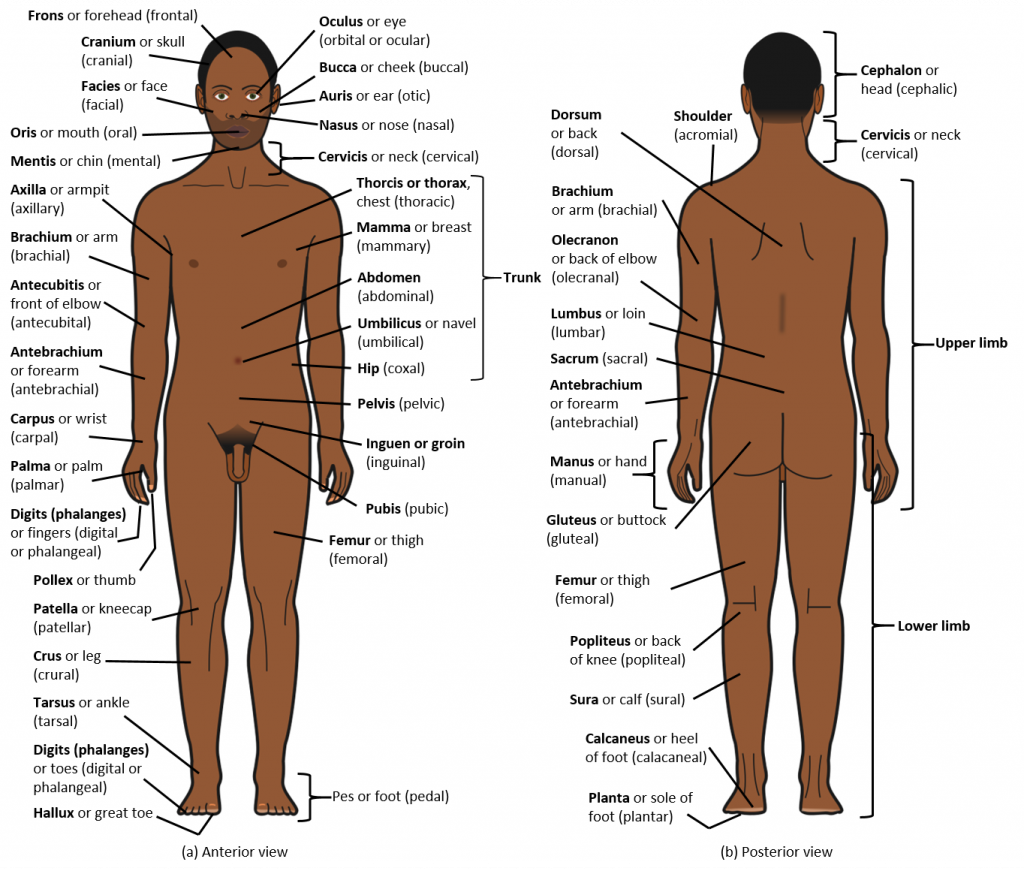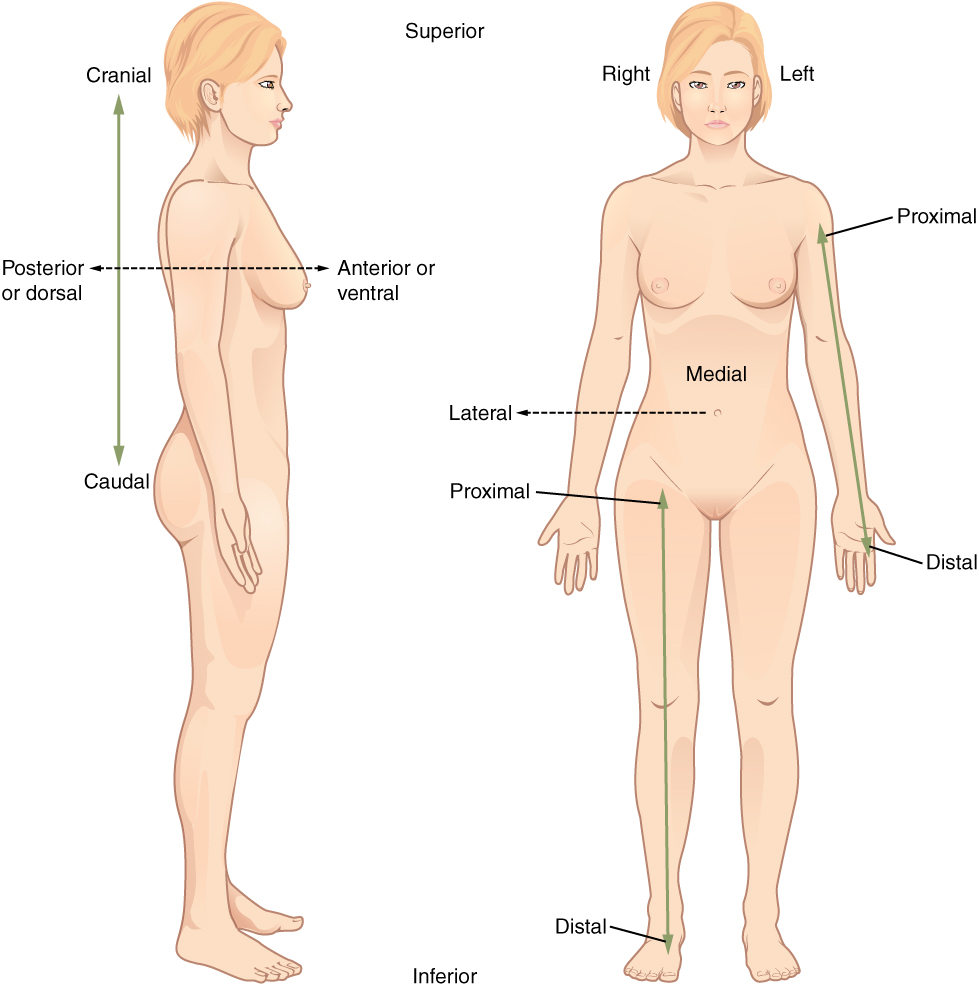Regional and Directional Terms
Anatomic Position
When describing anatomy, the anatomic position is used as a neutral, standard position of reference. The body is viewed standing upright, feet hip-width apart; standing on tip-toes, with hands by your side, palms facing out. The directional terms are the same whether the body is standing or lying down face up.

Regional Terms
The human body’s numerous regions have specific terms to help increase precision. Notice that the term “brachium” or “arm” is reserved for the “upper arm,” and “antebrachium” or “forearm” is used rather than “lower arm.” Similarly, “femur” or “thigh” is correct, and “leg” or “crus” is reserved for the portion of the lower limb between the knee and the ankle. You will be able to describe the body’s regions using the terms from the anatomical position (Figure 2.1).
Directional Terms
Directional terms are essential for describing the relative locations of different body structures (Figure 2.2). For instance, an anatomist might describe one band of tissue as “inferior to” another, or a physician might describe a tumor as “superficial to” a deeper body structure. Below are terms, combining forms, definitions, and examples to help you learn and utilize directional terms.
Anterior (or Ventral)
Anter/o or ventr/o describes the front or direction toward the front of the body.
Example
Posterior (or Dorsal)
Poster/o or dors/o describes the back or direction toward the back of the body.
Example
Superior (or Cephalad)
Super/o describes a position above or higher than another part of the body proper.
Example
Inferior (or Caudal)
Infer/o or caud/o describes a position below or lower than another part of the body proper; near or toward the tail (in humans, the coccyx, or lowest part of the spinal column).
Example
Lateral
Later/o describes the side or direction toward the side of the body.
Example
Medial
Medi/o describes the middle or direction toward the middle of the body.
Example
Proximal
Proxim/o describes a position in a limb that is nearer to the point of attachment or the trunk of the body.
Example
Distal
Dist/o describes a position in a limb that is farther from the point of attachment or the trunk of the body.
Example
Superficial
Superficial describes a position closer to the surface of the body or above.
Example
Deep
Deep describes a position farther from the surface of the body.
Example

Image Descriptions
Figure 2.1 image description: This illustration shows an anterior and posterior view of the human body. The cranial region encompasses the upper part of the head, while the facial region encompasses the lower half of the head beginning below the ears. The eyes are referred to as the ocular region. The cheeks are referred to as the buccal region. The ears are referred to as the auricle or otic region. The nose is referred to as the nasal region. The chin is referred to as the mental region. The neck is referred to as the cervical region. The trunk of the body contains, from superior to inferior, the thoracic region encompassing the chest, the mammary region encompassing each breast, the abdominal region encompassing the stomach area, the coxal region encompassing the belt line, and the pubic region encompassing the area above the genitals. The umbilicus, or naval, is located at the center of the abdomen. The pelvis and legs contain, from superior to inferior, the inguinal or groin region between the legs and the genitals, the pubic region surrounding the genitals, the femoral region encompassing the thighs, the patellar region encompassing the knee, the crural region encompassing the lower leg, the tarsal region encompassing the ankle, the pedal region encompassing the foot, and the digital/phalangeal region encompassing the toes. The great toe is referred to as the hallux. The regions of the upper limbs, from superior to inferior, are the axillary region encompassing the armpit, the brachial region encompassing the upper arm, the antecubital region encompassing the front of the elbow, the antebrachial region encompassing the forearm, the carpal region encompassing the wrist, the palmar region encompassing the palm, and the digital/phalangeal region encompassing the fingers. The thumb is referred to as the pollux. The posterior view contains, from superior to inferior, the cervical region encompassing the neck, the dorsal region encompassing the upper back, and the lumbar region encompassing the lower back. The regions of the back of the arms, from superior to inferior, include the cervical region encompassing the neck, acromial region encompassing the shoulder, the brachial region encompassing the upper arm, the olecranal region encompassing the back of the elbow, the antebrachial region encompassing the back of the arm, and the manual region encompassing the palm of the hand. The posterior regions of the legs, from superior to inferior, include the gluteal region encompassing the buttocks, the femoral region encompassing the thigh, the popliteus region encompassing the back of the knee, the sural region encompassing the back of the lower leg, and the plantar region encompassing the sole of the foot. Some regions are combined into larger regions. These include the trunk, which is a combination of the thoracic, mammary, abdominal, naval, and coxal regions. The cephalic region is a combination of all of the head regions. The upper limb region is a combination of all of the arm regions. The lower limb region is a combination of all of the leg regions. [Return to Figure 2.1].
Figure 2.2 image description: This illustration shows two diagrams: one of a side view of a female and the other of an anterior view of a female. Each diagram shows directional terms using double-sided arrows. The cranial-distal arrow runs vertically behind the torso and lower abdomen. The cranial arrow is pointing toward the head while the caudal arrow is pointing toward the tail bone. The posterior/anterior arrow is running horizontally through the back and chest. The posterior or dorsal arrow is pointing toward the back while the anterior, or ventral arrow, is pointing toward the abdomen. On the anterior view, the proximal/distal arrow is on the right arm. The proximal arrow is pointing up toward the shoulder while the distal arrow is pointing down toward the hand. The lateral-medial arrow is a horizontal arrow on the abdomen. The medial arrow is pointing toward the navel while the lateral arrow is pointing away from the body to the right. Right refers to the right side of the woman’s body from her perspective while left refers to the left side of the woman’s body from her perspective. [Return to Figure 2.2].

